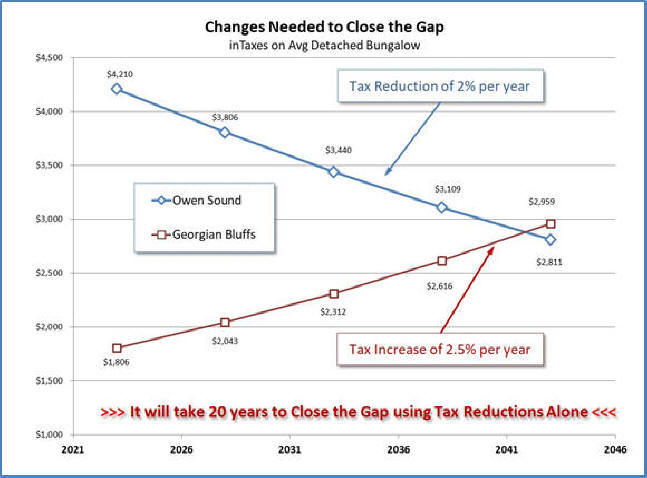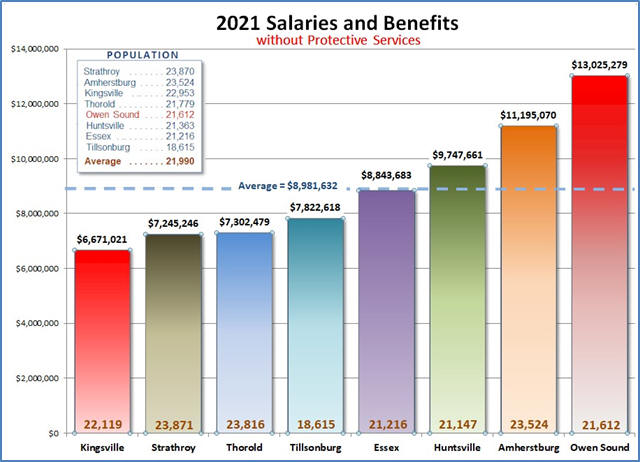|
Budget Process Improvements
|
| Seniors
Struggle - Rents Go Up - Residents are Push Out of the City |
 In reviewing last years budget,
some members of council pointed out, there is still a significant gap between
taxes in Owen Sound and taxes in our nearest neighbours in Georgian Bluffs. The
owner of an average detached bungalow in Georgian Bluffs currently pays $1,806
in taxes while an owner of the same property in Owen Sound pays $4,210. This is
a huge gap that is stifling Owen Soundís growth and encouraging residents to
move across the city boundary where they can save $2,404 per year in taxes while
still enjoying everything that Owen Sound has to offer. Therefore there is much
more to do to reduce this disparity.
In reviewing last years budget,
some members of council pointed out, there is still a significant gap between
taxes in Owen Sound and taxes in our nearest neighbours in Georgian Bluffs. The
owner of an average detached bungalow in Georgian Bluffs currently pays $1,806
in taxes while an owner of the same property in Owen Sound pays $4,210. This is
a huge gap that is stifling Owen Soundís growth and encouraging residents to
move across the city boundary where they can save $2,404 per year in taxes while
still enjoying everything that Owen Sound has to offer. Therefore there is much
more to do to reduce this disparity.
Changing the Budget Process
If we are to make
any significant inroads in achieving property taxes that are competitive with
our neighbours then we will have to change the budget preparation process. These
changes should include tools such as ďZero-Based
BudgetingĒ that I recommended in my
Road to Recovery article. However the real change thatís needed is how the
budget is reviewed. That year our part-time council spent a little over six
hours reviewing the draft operating budget containing $39 million in spending.
Although Iím sure they each devoted much more than this in their preparation for
the review, six hours of formal review does not reflect the importance of a $39
million budget. For the most part they had to depend on an overview of the
budget presented by the Director of Corporate Services. As the Director
correctly pointed out there was no time to go into a lot of detail at the
department level - sarcasm intended!
The Solution
What we need
Council to do is to devote much more time to the budget process. The review
period should be two weeks and the process should include the review of each and
every department budget, line-by-line. To enable this each member of council
should be paid a full time salary, at the city manager level, during which will
likely be an intense two week budget review process. This will cost taxpayers in
the order of $60,000 to $70,000. However, the return on this investment to
taxpayers can be enormous. This would allow members of council to take a short
leave of absence from their full time employment. In this process each budget
manager would present their budget and have an opportunity to fully justify each
and every line item. Ideally, each budget would start from a zero base as
opposed to what was spent the previous year.
Closing the Gap
During the budget
review process the Deputy Mayor acknowledged that, although we made good
progress in keeping the budget increase to a minimum, we still had quite a way
to go to eliminate the gap in taxes between us and our surrounding
municipalities. There really is only one way of closing the tax gap and that is
to reduce expenses. This year we witnessed a significant reduction in the annual
tax increase, however it will take sixty years to completely close the gap with
Georgian Bluffs if we just keep tax increases at less than one percent. Closing
the gap in our lifetime can only be achieved with annual
tax reductions combined with significant one-time
expense reductions.
 |
|
Closing the Gap with Annual Tax Reductions
|
As shown in the
graph above, if we were to have successive annual tax reductions of 2%, and
Georgian Bluffs were to increase their taxes on average by 2.5%, it would take
20 years to completely close the gap. So in order to reduce the gap over a
reasonable time period, it will also require one-time reductions in expenses, in
addition to annual tax reductions.
There are three
areas that should be seriously considered for significant expense reductions.
They are: the Art Gallery, the Transit System and the Workforce. I will examine
each of these for their potential in closing the tax gap.
Examining the Art Gallery
With respect to
the Art Gallery, Iíve mentioned in previous papers that we learned in the
community survey that the Art Gallery is valued by less than 8% of the
community. Their budget is $506,000 and has nearly doubled over the past 5
years. The cost to taxpayers is currently $475,000 year. the survey also showed
that 76% of the community either never or rarely use this facility.
Last fall I sat
down with the Director of Gallery to discuss the need to improve the Galleryís
profile in the community. I suggested that the Gallery needed to reach out,
beyond the art community, by rolling out more community-based art education
programs. I also suggested that regular presentations at our schools and college
would vastly improve both community engagement and the value of the Gallery in
the eyes of taxpayers. I also identified business graduate schools as a
cost-free source of expertise to develop a new business plan and a revised
community-focused marketing strategy.
I truly believe
that implementing these suggestions could greatly improve the value of the
Gallery in the eyes of the taxpayer. However, in the absence of a successful
community engagement program, along with an education program that is highly
valued by the community, the return on our annual
$505,000 expenditure is just not justified.
Staff Reductions - Right-Sizing the
Workforce
As I suggested
above we needed a two percent annual budget reduction. To facilitate this we
need to increase the time devoted to review the budget to two full weeks instead
of just two days. To make this happen I suggested that members of Council should
be properly compensated for their time at the city managerís salary level.
(This is a very small, but important, investment that will
produce a significant return to taxpayers) This, along with three
one-time budget reductions, will be necessary to reduce the gap in taxes between
Owen Sound and Georgian Bluffs within a reasonable time period.
I will now discuss
the third potential area that Council needs to address Ė staff reductions at
city hall. I first raised the need for this in my article,
Comparing Owen Sound Salaries and Benefits last year.
To begin, I
reviewed the 2021 audit financial statements for eight similarly sized
municipalities. I extracted the total that each municipality paid in Salaries
and Benefits. Since some municipalities contract for fire and police services,
so I removed all protective services salaries from the data. The graph below
shows what each municipality paid in Salaries and Benefits for all areas except
for Protective Services in 2021.
 |
|
Salaries and Benefits Expense for Similarly Sized Municipalities |
As you can see
there are four municipalities with greater populations than Owen Sound and three
with lower populations. The average salary expense for these municipalities,
excluding protective services salaries, was just about $9 million. Huntsville,
Amherstburg and Owen Sound all have a Salary Expense greater than the average.
Owen Sound spent
$13 million on Salaries & Benefits, excluding Protective Services salaries. To
reduce Owen Soundís expense to the average of $9 million, an annual expense
reduction of $4 million would be required. This represents a
10.2% tax reduction.
One Part of the Problem
As I mentioned above this data was acquired using each
municipalityís audit financial statements. These statements do not provide any
visibility into the number of employees in each municipality. However we can get
a feeling the portion of each municipalityís salary expense involving management
by looking at the numbers of managers with salaries greater than $100,000.
As shown above the
average number of managers, in municipalities in the comparative group, on the
Ontario Sunshine List is 12.8. Amherstburg, Essex and Owen Sound all have more
that the average number of employees earning more than $100,000 with Owen Sound
having the greatest number at 19. This seems to confirm that when it comes to
managerial salary expense, Owen Sound leads the pack, at least in this group of
municipalities.
|
 |
|
Estimate Number of Managers |
Most municipalities
post either their organization charts or staff directories on their websites.
Using this information along with their budget books we can get an estimate of
the number of managers employed at the municipality. This information was only
available on the above five municipalityís websites. Itís important to note that
these sources give us only an estimate of the actual numbers since this
information is often updated. The most reliable data was from those
municipalities that had their current organization charts on their websites.
As shown above, it
is estimated that Owen Sound employs approximately 29 managers based on
information gleaned from the city staff directory and confirmed by the 2021
budget book. In contrast, Strathroy, that has a population that is slightly
greater than Owen Sound, yet employs only 15 managers to manage its
municipality. The fact that it appears that Owen Sound needs 14 more managers
suggests that the workforce is top-heavy and that the management ranks needs to
be downsized.
The question is; by
how much? The average number of managers in this group is 20.2 so this should be
the targeted size of the management team. This would require a reduction of 9
managers. This would result in an annual savings in the order of one million
dollars or about a 2.7% tax reduction.
Although this is at
best an estimate of the number of managers it does correlate with data from more
reliable sources such as the Audited Financial Statements and the Ontario
Sunshine List. However, all of this data combined gives Council ample
justification to begin the process of ďright-sizingĒ the management team and
examine the entire workforce for areas that can be downsized to bring Owen
Soundís Salary Expense more in line with similarly sized municipalities.
Summary
-
Annual tax reductions are not sufficient to close the gap in
taxes with Georgian Bluffs within a reasonable timeframe. One-time expense
reductions will also be required. The two obvious candidates to reduce the
burden on taxpayers are the Art Gallery and Transit Services and, like the
Airport, should be the subject of significant change or deletion.
-
Owen Soundís workforce has grown well beyond that employed by
other, similarly sized, municipalities and has been excessively high for
many years. The workforce in general is much larger than needed. However,
the management team is, at a minimum, carrying 8-9 managers more than needed
in comparison with other similarly sized municipalities.
-
Although the current Council did not contribute to this
problem in the 2023 budget, unlike other Councils over the past 50 years, it
is this Council that needs to find the courage to take all steps necessary
to bring Owen Soundís taxes in line with our surrounding municipalities
within a reasonable timeframe.
What do You Think?
|
|
Take the time to leave your comments on
this site.
|
|
 In reviewing last years budget,
some members of council pointed out, there is still a significant gap between
taxes in Owen Sound and taxes in our nearest neighbours in Georgian Bluffs. The
owner of an average detached bungalow in Georgian Bluffs currently pays $1,806
in taxes while an owner of the same property in Owen Sound pays $4,210. This is
a huge gap that is stifling Owen Soundís growth and encouraging residents to
move across the city boundary where they can save $2,404 per year in taxes while
still enjoying everything that Owen Sound has to offer. Therefore there is much
more to do to reduce this disparity.
In reviewing last years budget,
some members of council pointed out, there is still a significant gap between
taxes in Owen Sound and taxes in our nearest neighbours in Georgian Bluffs. The
owner of an average detached bungalow in Georgian Bluffs currently pays $1,806
in taxes while an owner of the same property in Owen Sound pays $4,210. This is
a huge gap that is stifling Owen Soundís growth and encouraging residents to
move across the city boundary where they can save $2,404 per year in taxes while
still enjoying everything that Owen Sound has to offer. Therefore there is much
more to do to reduce this disparity.


